Jaai Deolalkar and Sowmya Ravindranath
In a bustling breakfast meeting for teachers from different schools, a few of them sit down as they greet unfamiliar faces and discuss familiar narratives. “What activities do you have in your school?” comes a question. The writers (of this article) look at each other and chat about a set of pursuits children enjoy on campus – tree-climbing, seed-pod collecting, going on long walks, etc., we list. “But what about art – what art activities do you offer?” the teacher insists. “Oh, art!” Now, we talk about the art program as more teachers join the table. “Really?! That is extensive. How do you make time for art on your timetable?” comes the next question. We discuss how timetabling is approached and strategies that have worked well. But curiously, this conversation unravelled something deeper – both logistical and philosophical. Is art a subject? Does it have a curricular role? What is the place of art in education?
We returned and steeped in the warm spotlight of this deliberation, discussed with colleagues – current and former, to come away being enamoured with how the art program had grown over the years.
To be a painter, you must know yourself and to know yourself is extremely difficult, but to learn a technique of painting is comparatively easy.
– J. Krishnamurti
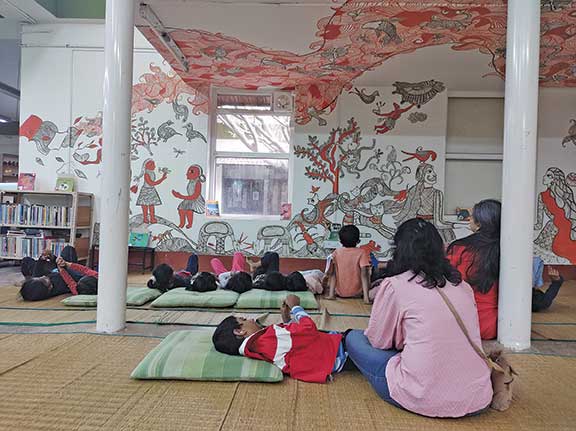
The setting
The verdant campus of The Valley School lays a fertile ground for self-exploration. From finding inspiration and a space for quiet to collecting natural materials, it is a privilege to be cradled in this green expanse. The art program, therefore, draws from the lush surroundings. It facilitates an exploration – of the outer world and the inner world with appreciation and aesthetics.
Art classes are hosted in what is lovingly referred to as the Art Village. An integral part of the school, Art Village is a magical space where the sounds of handlooms, chisels, and hammers sweeten the rhythms of the bustling studios. It is here, where creativity takes shape, form, and expression. It is here, where students and teachers immerse in painting, pottery-ceramics, thread craft-weaving, and sculpture-carpentry. The music and dance studios buzz with energy as students explore tabla, mridangam, and theatre. Throughout the week, grades 1 to 12 visit the Art Village to explore visual and performing arts. Over their years in school, students are exposed to 4-5 different visual art mediums, while learning in a vibrant setting.
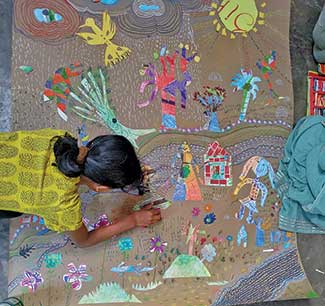
Drawing inspiration
If one had to choose the common lexicon of art and children, it would begin with wonder – an unrestrained sense of wonder that permeates imagination and creation. A stroll to the Art Village offers myriad inspirations for the wandering and the wonder-ing. Art teachers often welcome groups of children who have turned the walk to their classes into an exercise in foraging – a wood apple here, a few tamarind pods there, a stash of winged seeds and leaves, or a roly-poly (insect) in little hands is a common sight. Sometimes, the foraged inspires the artwork, allowing for a more visceral experience. Paying close attention to all that is near and immediate builds a capacity for silence – an essential part of engaging in the arts. Classes could begin with watching a Paradise flycatcher dance from tree to tree, or listening to the White-rumped shama’s melodious song, or the orchestra organized by the gushing stream nearby. “Close your eyes, listen to the music, and draw on the paper with pastels; allow your hand to follow the rhythm”, the teacher says, setting the pace of leisure. The class tunes in, each one interpreting the music with different strokes. In another class exploring watercolours, a boy sits in the corner with a blank piece of paper. “Why is your brush not dancing on the paper?”, the teacher asks him. “The brush wants to swim in the water”, he says and demonstrates how two shades are blending, while the paintbrush appears to be examining, as he does, the swirl and vibrance of the water bowl. There may have been no artwork on his piece of paper, but the observation gave the boy immersive moments of wonderment.
When children are invited to draw or paint, a blank piece of paper can be quite daunting. As delightfully described in the book “The Dot” by Peter H Reynolds – a blank sheet of paper could be a ‘polar bear in a snowstorm’. The challenge lies in embracing the uncertainty and staying with it. This process involves responding to the situation and transforming it into an opportunity for creativity. As educators, we may be conscious of our pursuit of an outcome. But what is worth exploring is this: are we missing the trees for the forest?
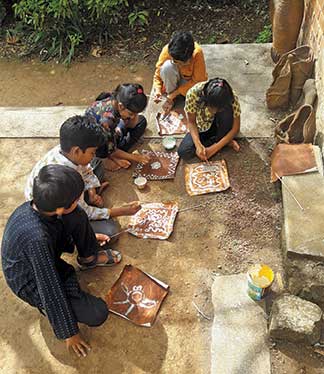
Brush strokes
Two famous quotes by Picasso: “Every child is an artist. The problem is how to remain an artist once he grows up” and “It took me four years to paint like Raphael, but a lifetime to paint like a child”, draw our attention to the irrepressible urge and spirit of creation that a child possesses. But, the architecture of ‘learning’ leans on the accumulation of skills and techniques. How then does one fan the fire of art engagement without an overwhelming focus on proficiency?
The key is to nurture the innocence inherent in a child’s artistic expression, allowing them to experiment freely beyond external influences. This means encouraging them to explore their ideas, embrace uniqueness, and teaching them to respond to the visual language they are creating on the canvas or paper. In this way, the focus is on the journey of self-discovery and artistic exploration rather than conforming to preconceived notions or expectations. Many times, teachers or facilitators try not to ask children to work on a given topic or idea, instead, open-ended simple techniques, like how to handle a pencil or brush are the prompts. For younger kids, learning happens through play – playing with lines, colours, clay, or thread, and experimenting with textures, or trying various methods of colouring. The learning process becomes enjoyable when there’s a sense of openness and a playful approach to action. The attempt is to help them break free from imitating famous artworks, commonly appreciated styles, or even one’s art.
Culture of art appreciation
To offer an art program to students is to be awake and alive to the possibilities of the now and near. Art need not be what one engages in the scheduled confines of a timetable. A culture of art immersion aids in building a consciousness to comprehend and respond to art and aesthetics.
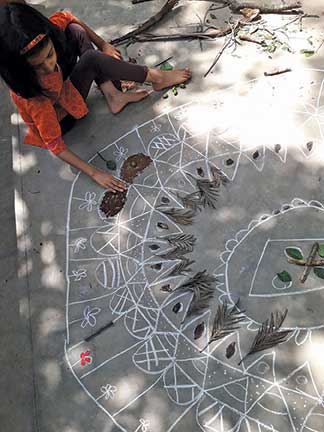
That art can fuel cross-disciplinary curiosity creates infinite possibilities. A few years ago, the middle school students were encouraged to learn about India through the different folk-art forms. The library was converted into an art gallery, dotted with books and art pieces in different styles – Gond, Bhil, Warli, Madhubani, Mandana, Kalamkari, and more. Original Pattachitra scrolls gifted by visiting artisans sparked awe and intrigue. As the art teacher unpacked the history of the art forms, the children went on a gallery walk, pausing to notice the nuances in line work, motifs, and their cultural references. The children dug into reading material, and the library brimmed with questions and eagerness, leading to two weeks of immersion in the folk-art forms.
Similarly, an English teacher developed a special art appreciation module for creative writing. The children were invited to pick various art pieces around the school – from sculptures and murals to wall paintings, and craft essays about them. The teacher emphasized the importance of not just describing the art but capturing the visual experience without relying solely on words. The message was clear: paintings and sculptures are more than just pictures or objects; they offer a unique visual encounter that can’t always be perfectly expressed through language.
The school regularly hosts workshops by artists and artisans. Open to students and parents, these workshops not only familiarize learners with the craft but also the intimate and lived realities of the artisans. Hussainbi and Fatimabi ajji are two Siddi women from the dense forests of Dandeli. As they demonstrate their intricate art of quilt-making, their quest for prudence – in using up even the smallest piece of cloth gives a peek into their way of living. Their Kaudis, swollen fingers, and stories offer a glimpse of how folk arts keep sustainability at the heart of art and aesthetics.
Whether it’s the magical natural dyes in Kalamkari intriguing the chemistry students or the value of involvement and detachment evinced by the Buddhist monks creating mandalas, each of these artisans builds our capacity to look at the multi-layered facets of art.
Campus as the canvas
All creative endeavours need a canvas. In the past few years, students and teachers have added their artistic touch to the campus, leaving a luminous reminder to slow down and appreciate. Painting walls and creating murals is a much-anticipated and enjoyed group activity. Led by the art teacher, students take on these projects which could last a few weeks or months. From drawing with chalk on the floor to accommodating each other’s expressions and complementing forms, colours, and textures, murals have been momentous pursuits in kinship and engagement, especially post-covid.
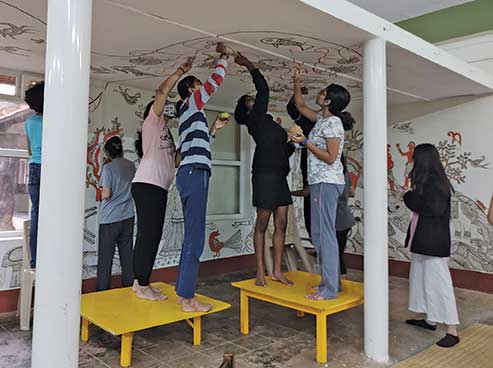
Recently, a group of 12th-grade students took on a project to create a mural in the library. A wall and a section of the roof were identified as the canvas. To arrive at the composition, the teachers organized the reading of books. From immersing in poetry and folktales to reading books about books, the group pored over a curated collection, drawing and deliberating on the floor before they took their ideas to the wall. A reading of ‘A Book is a Bee’ by children’s author Lavanya Karthik and a few wonderful letters from ‘A Velocity of Being’ by Maria Popova surged the ideas into patterns and graceful lines. Over the next few weeks, students from various classes lay beneath the painted canopy as they spun countless stories and poems inspired by the artwork.
Art as social capital
The Annual Art Mela is one more opportunity where the whole school, from adults to children, gets together. Mela is a convergence for the current, former, and extended family of the school to engage in artistic explorations. Creative murmurations built over the year constellate to reverberate with joy. Works of art are displayed and celebrated; music and storytelling hyphenate the backscore of the day, making the atmosphere vibrant and festive. This allows for even the reluctant to abandon their inhibitions and dive in. From claywork, woodwork, painting to papercraft and thread-craft, the Mela hosts an array of arts and crafts. But it is the coming together of people, the weeks spent in preparing for the event that lays testimony to the undeniable power of art to announce a sense of the possible.
Jaai Deolalkar is an art educator, and Sowmya Ravindranath is a library educator at the Valley School, Bangalore. They can be reached at jaai.deolalkar@thevalleyschool.info and sowmya.ravindranath@thevalleyschool.info.
Related Articles
Arts equalize, not divide. Arts are freeing, not restrictive
